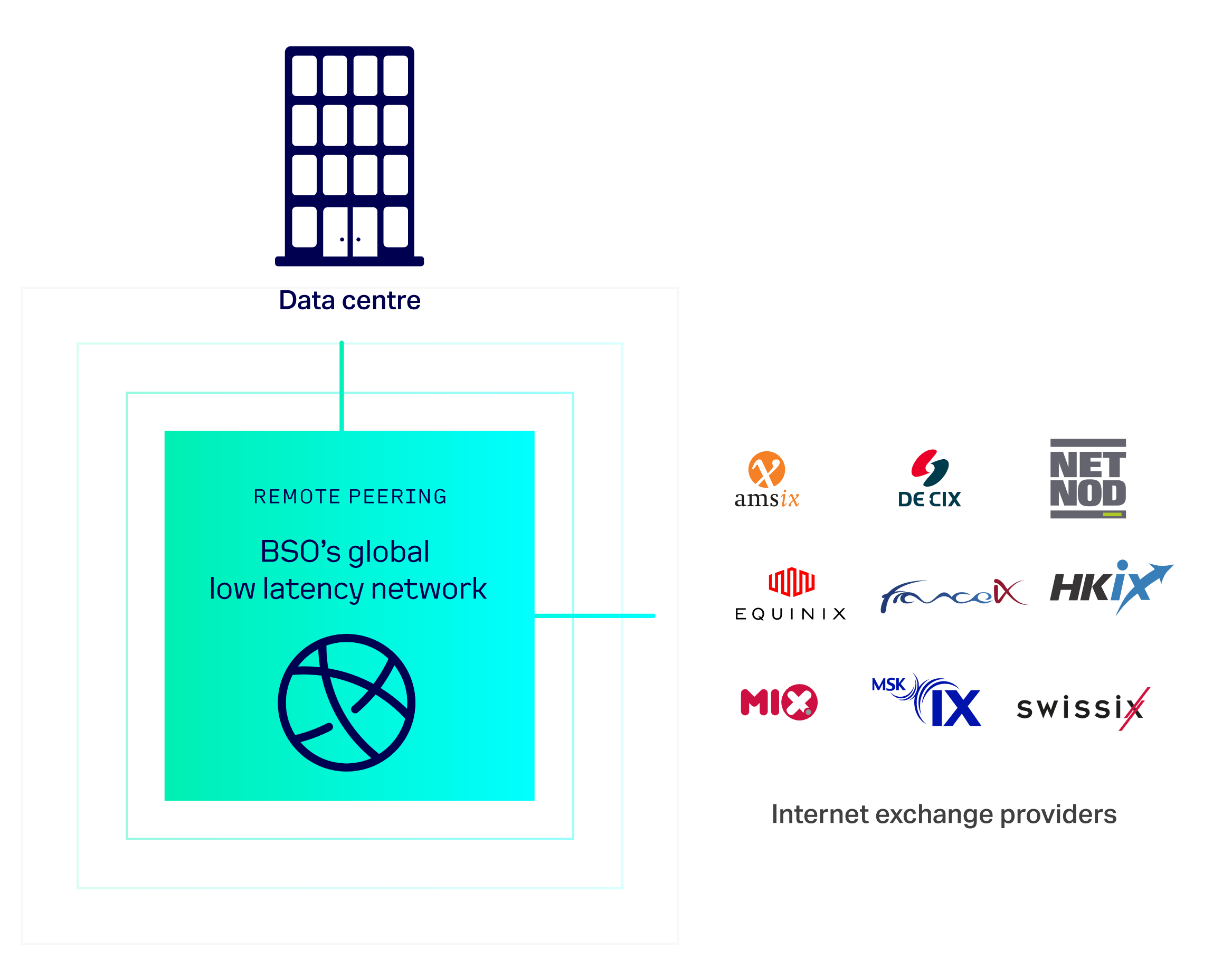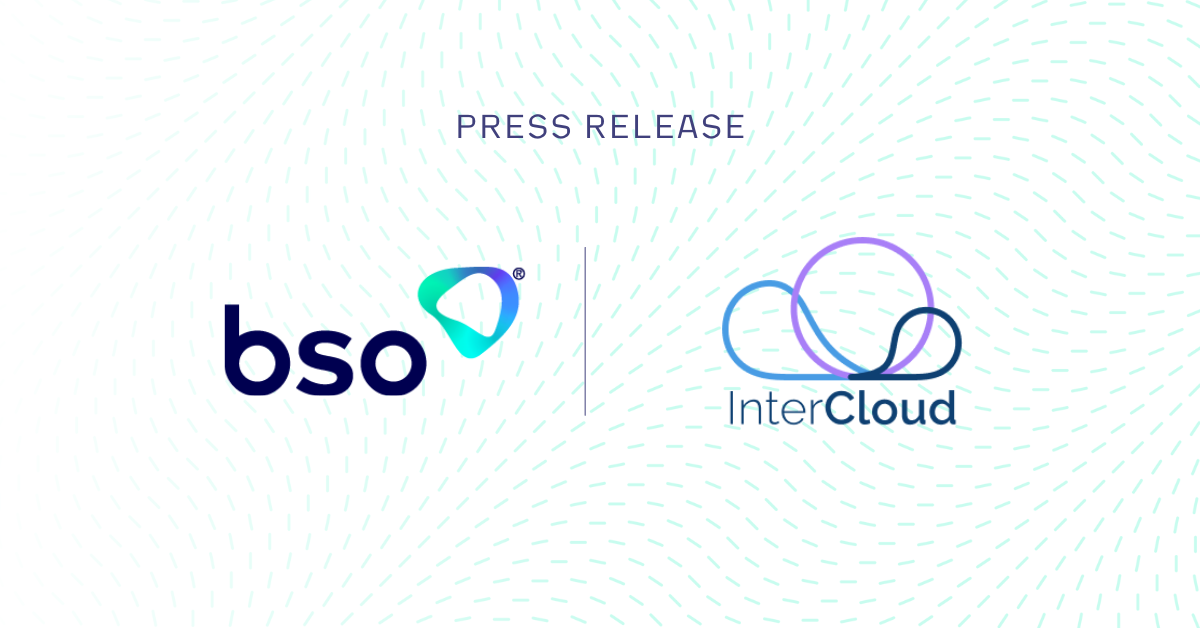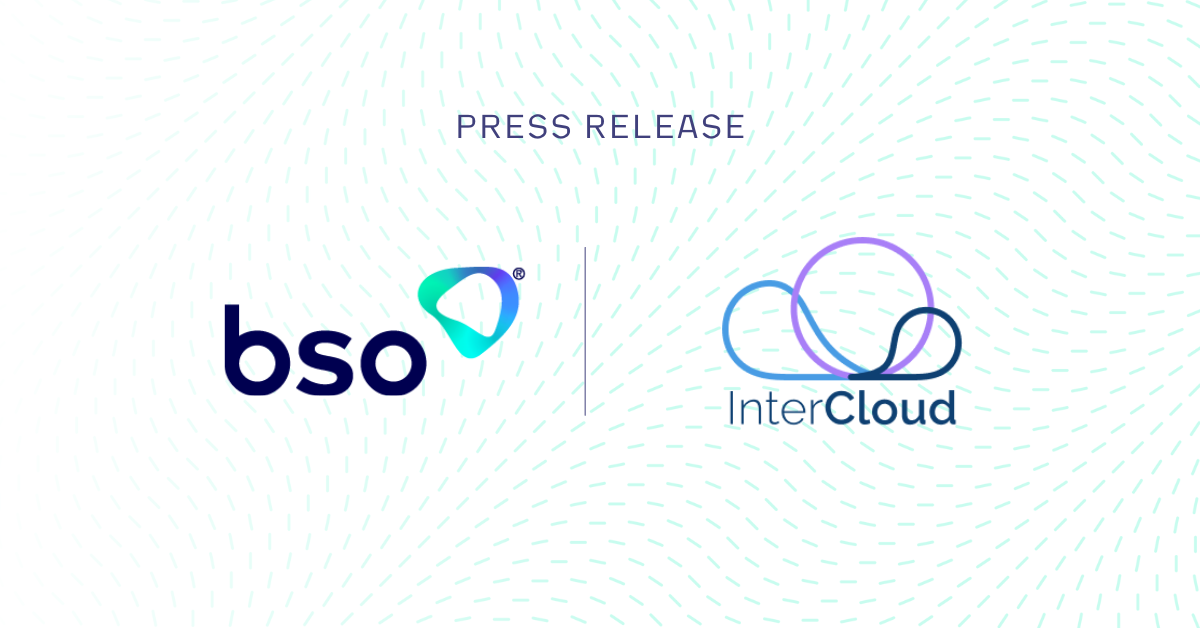PRODUCTS
Remote Peering_
Peering made easy_
BSO Remote Peering makes multi-region peering more accessible, more efficient and easier to manage than any other solution available on the market. BSO has more internet exchanges (IXs) on our network than anyone else too.
BUILT FOR CONNECTIVITY
We don’t mean to brag…We have more IXs on our network than anyone else!


OUR SERVICE
A complete solution for peering_
Remote Peering simplifies how your organisation peers across internet exchanges. Our service includes your IX connectivity and management of individual ports membership fees.
Our centralised service is available across 240 POPs to 75+ exchanges, including AMS-IX, DE-CIX, LINX, SIX, HKIX and Equinix. Remote Peering supports connections from 100Mbps to 100Gbps.
Our network-to-network interfaces (NNIs) with our IX partners let us rapidly activate new connections.
Peering benefits_
Improved Network Performance
The most direct way to exchange traffic with other networks
Greater Control
Gain visibility into traffic patterns and flows between peered networks
OUR DIFFERENCE
Why BSO for Remote Peering?
One-to-many
Easily amplify your footprint by connecting to multiple internet exchanges from one location.
Low-risk expansion
Expand into new markets on a short-term basis cost effectively.
One contract
Eliminate multiple agreements with one contract and one service agreement.
Extensive reach
BSO Remote Peering has over 75 active internet exchanges.
PRODUCT SHEET
BSO’s Remote Peering product sheet_
JOIN OUR NETWORK
Not on-net with BSO?
We have great relationships with carriers around the world, all we need are your business objectives to provide the right assistance.
Transform your business with Remote Peering,
get in touch now_
FAQs
What is Remote Peering?
Remote peering is a networking practice that allows organisations to connect to an Internet Exchange Point (IXP) or another network provider's infrastructure without physically being present at the exchange point's location. It enables businesses to exchange internet traffic and connect to various content and service providers, cloud services, and other networks efficiently and cost-effectively, even when they are geographically distant from the exchange point.
How does BSO Remote Peering improve network performance?
BSO Remote Peering enhances network performance by simplifying multi-region peering and offering several benefits. It achieves this through:
Efficient multi-region peering: BSO Remote Peering provides access to 75+ exchanges across 240 Points of Presence, including major IXs, simplifying peering across multiple regions.
Centralised service: BSO manages both IX connectivity and port membership fees, reducing administrative complexity for organisations.
Scalable bandwidth options: It offers bandwidth options ranging from 100Mbps to 100Gbps, allowing organisations to adjust network resources to their needs.
Rapid activation: BSO's network-to-network interfaces with IX partners enable quick establishment and scaling of peering connections to adapt to changing network traffic.
What are the compatibility requirements for Remote Peering?
The compatibility requirements for remote peering typically involve having the necessary network infrastructure, BGP (Border Gateway Protocol) support, and an established presence in an internet exchange point (IXP) or peering facility where remote peering services are offered. Ensuring that your network equipment and configurations align with these requirements is essential for successful remote peering connections.
How secure is Remote Peering?
Remote peering can be secure when implemented with proper security measures. These measures often include encrypted connections, access controls, and monitoring to safeguard data transmitted between networks. Additionally, remote peering services are often provided within trusted and controlled peering environments, enhancing security. However, the overall security level may also depend on an organisation's specific configurations and practices, so it's essential to follow best security practices and protocols to maintain a secure Remote Peering connection.
What are the key features of Remote Peering?
Remote peering is a networking arrangement that allows organisations to connect to an internet exchange point (IXP) or peering point without physically colocating their equipment at the exchange point's facility. This remote connection offers several key features:
1. Cost-efficiency: Remote peering eliminates the need for expensive data centre space, power, and cooling infrastructure typically required for physical colocation. This can lead to significant cost savings for organisations.
2. Geographical flexibility: Remote peering enables organisations to establish peering connections with IXPs located in different geographic regions, providing access to a broader range of networks and content providers.
3. Reduced latency: By connecting remotely to an IXP, organisations can optimise their network routing and reduce latency since traffic doesn't need to traverse long distances to reach the exchange point.
4. Scalability: Remote peering allows for easy scalability as organisations can add or remove peering connections as needed without the constraints of physical infrastructure.
5. Resilience and redundancy: Remote peering can enhance network resilience and redundancy by establishing connections to multiple geographically distributed IXPs. This ensures that even if one connection or IXP experiences issues, traffic can be rerouted through alternative paths.
6. Simplified management: Managing peering relationships remotely can be more convenient and efficient, as it eliminates the need for on-site staff to maintain and troubleshoot physical equipment.
7. Security and control: Organisations maintain control over their routing policies and security measures while remotely peering, ensuring that they can protect their network assets and data.
8. Improved time-to-market: Remote peering enables quicker access to new markets and networks, facilitating faster expansion and the ability to reach a wider audience.
9. Network performance monitoring: Organisations can still monitor the performance of their peering connections remotely, using tools and protocols to ensure optimal network performance and traffic routing.
Can Remote Peering support multiple locations?
Certainly. BSO Network Remote Peering offers robust support for multiple locations, enhancing the efficiency and accessibility of multi-region peering. With an extensive network spanning 240 Points of Presence (POPs) and connectivity to 75+ major internet exchanges, including AMS-IX, DE-CIX, LINX, SIX, HKIX, and Equinix, BSO enables organisations to establish peering connections across various locations worldwide.





/Revolutionising-Connectivity%20BSOs-Tailored-Cloud-Solution-for-CryptoStruct-GmbH.png?width=1050&height=550&name=Revolutionising-Connectivity%20BSOs-Tailored-Cloud-Solution-for-CryptoStruct-GmbH.png)
/6%20Cloud%20Best%20Practices%20for%20Financial%20Technology%20Companies.jpg?width=1200&height=600&name=6%20Cloud%20Best%20Practices%20for%20Financial%20Technology%20Companies.jpg)



